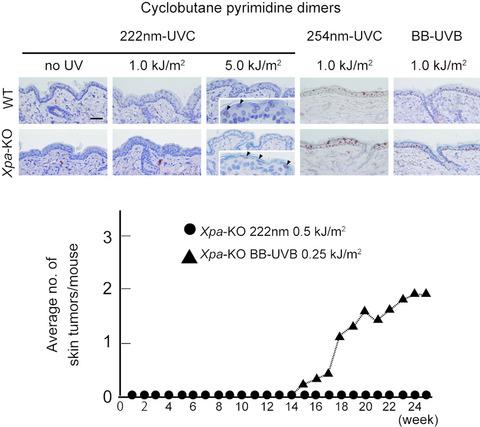当前位置:
X-MOL 学术
›
Photochem. Photobiol.
›
论文详情
Our official English website, www.x-mol.net, welcomes your feedback! (Note: you will need to create a separate account there.)
Long-term effects of 222 nm ultraviolet radiation C sterilizing lamps on mice susceptible to ultraviolet radiation
Photochemistry and Photobiology ( IF 3.3 ) Pub Date : 2020-05-31 , DOI: 10.1111/php.13269 Nozomi Yamano 1 , Makoto Kunisada 1 , Sachiko Kaidzu 2 , Kazunobu Sugihara 2 , Aiko Nishiaki-Sawada 3 , Hiroyuki Ohashi 3 , Ai Yoshioka 1 , Tatsushi Igarashi 3 , Akihiro Ohira 4 , Masaki Tanito 2 , Chikako Nishigori 1
Photochemistry and Photobiology ( IF 3.3 ) Pub Date : 2020-05-31 , DOI: 10.1111/php.13269 Nozomi Yamano 1 , Makoto Kunisada 1 , Sachiko Kaidzu 2 , Kazunobu Sugihara 2 , Aiko Nishiaki-Sawada 3 , Hiroyuki Ohashi 3 , Ai Yoshioka 1 , Tatsushi Igarashi 3 , Akihiro Ohira 4 , Masaki Tanito 2 , Chikako Nishigori 1
Affiliation

|
Germicidal lamps that emit primarily 254 nm ultraviolet radiation (UV) are routinely utilized for surface sterilization but cannot be used for human skin because they cause genotoxicity. As an alternative, 222‐nm UVC has been reported to exert sterilizing ability comparable to that of 254‐nm UVC without producing cyclobutane pyrimidine dimers (CPDs), the major DNA lesions caused by UV. However, there has been no clear evidence for safety in chronic exposure to skin, particularly with respect to carcinogenesis. We therefore investigated the long‐term effects of 222‐nm UVC on skin using a highly photocarcinogenic phenotype mice that lack xeroderma pigmentosum complementation group A (Xpa‐) gene, which is involved in repairing of CPDs. CPDs formation was recognized only uppermost layer of epidermis even with high dose of 222‐nm UVC exposure. No tumors were observed in Xpa‐knockout mice and wild‐type mice by repetitive irradiation with 222‐nm UVC, using a protocol which had shown to produce tumor in Xpa‐knockout mice irradiated with broad‐band UVB. Furthermore, erythema and ear swelling were not observed in both genotype mice following 222‐nm UVC exposure. Our data suggest that 222‐nm UVC lamps can be safely used for sterilizing human skin as far as the perspective of skin cancer development.
中文翻译:

222nm紫外线C杀菌灯对紫外线易感小鼠的长期影响
主要发射 254 nm 紫外线辐射 (UV) 的杀菌灯通常用于表面消毒,但不能用于人体皮肤,因为它们会引起基因毒性。作为替代方案,据报道,222 nm UVC 具有与 254 nm UVC 相当的杀菌能力,而不会产生环丁烷嘧啶二聚体 (CPD),这是由 UV 引起的主要 DNA 损伤。然而,没有明确的证据表明长期接触皮肤是安全的,特别是在致癌作用方面。因此,我们使用缺乏色素性干皮病互补组 A (Xpa-) 基因的高光致癌表型小鼠研究了 222 nm UVC 对皮肤的长期影响,该基因参与 CPD 的修复。即使在高剂量的 222 nm UVC 暴露下,CPD 的形成也只能被识别到表皮的最上层。使用已显示在用宽带 UVB 照射的 Xpa 基因敲除小鼠中产生肿瘤的方案,通过 222-nm UVC 重复照射在 Xpa 基因敲除小鼠和野生型小鼠中未观察到肿瘤。此外,在 222 nm UVC 暴露后,两种基因型小鼠均未观察到红斑和耳肿胀。我们的数据表明,从皮肤癌发展的角度来看,222 nm UVC 灯可以安全地用于对人体皮肤进行消毒。
更新日期:2020-05-31
中文翻译:

222nm紫外线C杀菌灯对紫外线易感小鼠的长期影响
主要发射 254 nm 紫外线辐射 (UV) 的杀菌灯通常用于表面消毒,但不能用于人体皮肤,因为它们会引起基因毒性。作为替代方案,据报道,222 nm UVC 具有与 254 nm UVC 相当的杀菌能力,而不会产生环丁烷嘧啶二聚体 (CPD),这是由 UV 引起的主要 DNA 损伤。然而,没有明确的证据表明长期接触皮肤是安全的,特别是在致癌作用方面。因此,我们使用缺乏色素性干皮病互补组 A (Xpa-) 基因的高光致癌表型小鼠研究了 222 nm UVC 对皮肤的长期影响,该基因参与 CPD 的修复。即使在高剂量的 222 nm UVC 暴露下,CPD 的形成也只能被识别到表皮的最上层。使用已显示在用宽带 UVB 照射的 Xpa 基因敲除小鼠中产生肿瘤的方案,通过 222-nm UVC 重复照射在 Xpa 基因敲除小鼠和野生型小鼠中未观察到肿瘤。此外,在 222 nm UVC 暴露后,两种基因型小鼠均未观察到红斑和耳肿胀。我们的数据表明,从皮肤癌发展的角度来看,222 nm UVC 灯可以安全地用于对人体皮肤进行消毒。


























 京公网安备 11010802027423号
京公网安备 11010802027423号